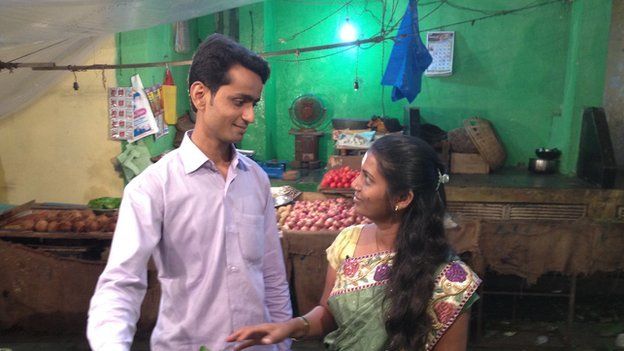Caste or Class?
- Published

By 2027, India is projected to have the biggest middle class population in the world. In a society fragmented by caste, there has been much debate about whether recent economic growth has reached the country's most disadvantaged groups.
While the change is slow, there are signs that economic growth and education are helping to bring down social barriers.
On a rainy monsoon day in Mumbai, Vishal Nalawade holds up an umbrella and escorts his new wife to the vegetable market. Vishal married Shraddha Meshram three months ago and the two have paid a heavy price to be together.
Vishal and Shraddha have been forced to cut ties with their families who opposed the match because they belong to different castes.
Caste is a hereditary division rooted in Hindu society. It's based on a number of factors, but primary among these are occupation and social ranking.
Vishal is a web developer while Shraddha works in public relations. They are both well educated and have good job prospects but none of this mattered to their parents when it came to marriage.
Inter-caste marriages are largely frowned upon in India. There have even been cases where couples who married outside their caste were murdered by their own families. The term "honour killing" has been used to describe this.
But many from India's large young population are choosing to look beyond traditional caste hierarchies.
Watch: India's swelling middle class is reshaping the country's social categories. Yogita Limaye reports.
"I married Vishal because he is a genuine, hard-working person. When we were children, we were told about caste and religion. But as we grew up and got educated, we began to realise that these factors aren't so important.
"I think over the next two or three generations, caste divisions will disappear," says Shraddha.
Her view is reflected in trends being noted by matchmaking services. Matrimonial website shaadi.com is one of the largest in India. When creating a profile on this website, the user needs to select their caste from a dropdown menu with more than 400 choices.
But just below this the portal has introduced a little box to ask if the person is not particular about their partner's caste. The company has found that many are choosing to tick this box.
"In India, it's very much about two families marrying one another. I think in the past, caste was that indicator of inter-family compatibility. I think it's becoming much less relevant now and what we're seeing is over 50% of our audience is saying I'm not looking to marry into the caste I belong to," says Gourav Rakshit, Chief Operating Officer at shaadi.com.
But it's not just marriage where caste plays a big role. Traditionally it also dictated what job you could do. People from the lowest caste were forced to do the most menial jobs. Some were even termed untouchables.
The global middle class revolution
To remove this inequality, seats have been reserved for students from lower castes in educational institutes around the country. This quota system also extends to government jobs.
A proposal to introduce caste-based reservations in the private sector sparked fierce debate about whether such policies were fair. Many say they are needed to make up for decades of missed opportunities for people from India's lowest castes.
"The reservation policies that we have, have actually not reached the largest number of people. They've just reached the tip of the iceberg," says Dr Gita Chadha, a sociologist at the University of Mumbai.
"Now there is a move to ask for reservations in the private sector and we are hoping this will happen," she adds.
Studies have found that very few people from lower castes own businesses in India, but it is a number that is growing.
Sachin Shinde belongs to a caste that would have forced him to be a cobbler some decades ago. But today Mr Shinde owns two small workshops where he employs close to fifteen people.
He makes leather goods like wallets, belts and shoes for luxury hotels. Sachin has a business management degree from a foreign university and dreams of creating his own big brand.
"When I go to clients for business, no one asks me which caste I belong to. They only see my products. It hasn't been a factor when getting jobs either," he says.
"But I have faced discrimination earlier in life. When I went to a bank to get an education loan some years ago to go study in the UK, people there commented about how a person from my caste could think of going abroad. I didn't like that."
Entrepreneurs like Mr Shinde now have a chamber of commerce to back them up. The organisation is exclusively aimed at helping start-up businesses promoted by people from lower castes.
India's finance minister P. Chidambaram recently said that every bank branch in the country must hand-hold an entrepreneur from a lower caste and that such a move could have a ripple effect on the economy.
At present much of India is still fragmented by caste. But two decades of economic liberalisation, government policies and increased awareness among people themselves have kick-started the process of change.
It is unlikely that there will be a complete transformation soon, but some say that for a country shackled with centuries of discrimination even a start is good news.